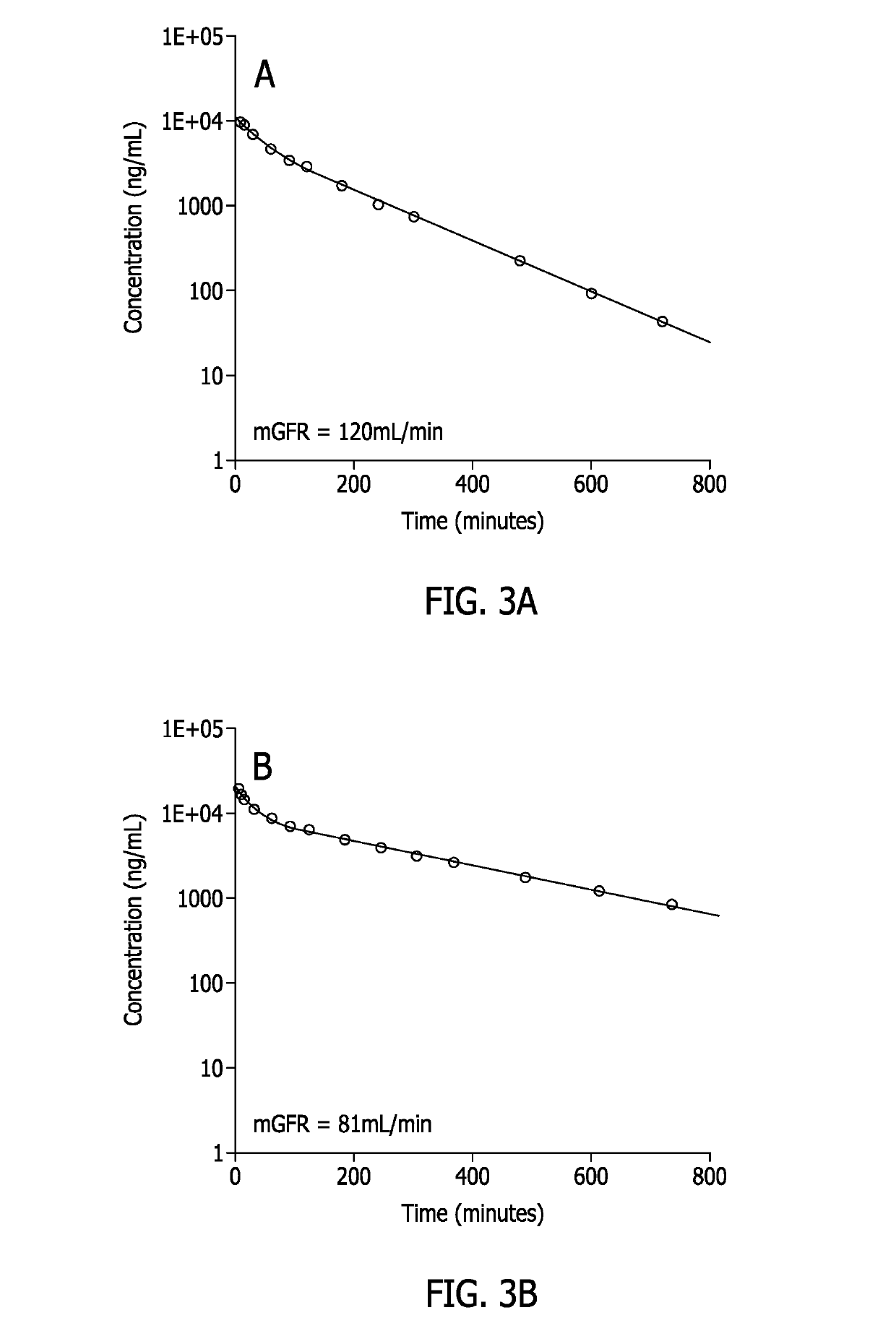Methods for renal function determination
- Summary
- Abstract
- Description
- Claims
- Application Information
AI Technical Summary
Benefits of technology
Problems solved by technology
Method used
Image
Examples
example 1
Preparation of 3,6-diamino-N2,N2,N5,N5-tetrakis(2-methoxyethyl)pyrazine-2,5-dicarboxamide
[0117]
[0118]A mixture of 3,6-diaminopyrazine-2,5-dicarboxylic acid (200 mg, 1.01 mmol), bis-2-(methoxyethyl)amine (372 μL, 335.5 mg, 2.52 mmol), HOBt.H2O (459 mg, 3.00 mmol), and EDC.HCl (575 mg, 3.00 mmol) were stirred together in DMF (20 mL) for 1 h at room temperature. The mixture was concentrated to dryness and the residue was partitioned with EtOAc and water. The layers were separated and the EtOAc solution was washed with saturated NaHCO3 and brine. The solution was dried over anhydrous Na2SO4, filtered and concentrated. Purification by radial flash chromatography (SiO2, 10 / 1 CHCl3-MeOH) afforded 228.7 mg (53% yield) of Example 1 as an orange foam: 1H NMR (300 MHz, CDCl3), δ 4.92 (s, 4H), 3.76 (apparent t, J=5.4 Hz, 4H), 3.70 (apparent t, J=5.6 Hz, 4H), 3.64 (apparent t, J=5.4 Hz, 4H), 3.565 (apparent t, J=5.4 Hz), 3.67 (s, 6H), 3.28 (s, 6H). 13C NMR (75 MHz, CDCl3) δ 167.6 (s), 145.6 (s),...
example 2
3,6-diamino-N2,N5-bis(2,3-dihydroxypropyl)pyrazine-2,5-dicarboxamide
[0119]
Step 1. Synthesis of 3,6-diamino-N2,N5-bis((2,2-dimethyl-1,3-dioxolan-4-yl)methyl)pyrazine-2,5-dicarboxamide
[0120]
[0121]A mixture of 3,6-diaminopyrazine-2,5-dicarboxylic acid (350 mg, 1.77 mmol), racemic (2,2-dimethyl-1,3-dioxolan-4-yl)methanamine (933 μL, 944 mg, 7.20 mmol), HOBt.H2O (812 mg, 5.3 mmol), and EDC.HCl (1.02 g, 5.32 mmol) were stirred together in DMF (20 mL) for 16 h at room temperature. The mixture was concentrated to dryness and the residue was partitioned with EtOAc and water. The layers were separated and the EtOAc solution was washed with saturated NaHCO3 and brine. The solution was dried over anhydrous Na2SO4, filtered and concentrated to afford 665 mg (88% yield) of the bis-amide diastereomeric pair as a yellow solid: 1NMR (300 MHz, CDCl3) δ 8.38 (t, J=5.8 Hz, 2H), 6.55 (s, 4H), 4.21 (quintet, J=5.8 Hz, 2H), 3.98 (dd, J=8.4 Hz, 6.3 Hz, 2H), 3.65 (dd, J=8.4 Hz, J=5.8 Hz, 2H), 3.39 (apparent...
example 3
(2S,2′S)-2,2′-((3,6-diaminopyrazine-2,5-dicarbonyl)bis(azanediyl))bis(3-hydroxypropanoic acid)
[0123]
Step 1. Synthesis of dimethyl 2,2′-((3,6-diaminopyrazine-2,5-dicarbonyl)bis(azanediyl))(2S,2′S)-bis(3-(benzyloxy)propanoate)
[0124]
[0125]A mixture of sodium 3,6-diaminopyrazine-2,5-dicarboxylate (300 mg, 1.24 mmol), L-Ser(OBn)-OMe.HCl salt (647 mg, 2.64 mmol), HOBt.H2O (570 mg, 3.72 mmol) and EDC.HCl (690 mg, 3.60 mmol) in DMF (25 mL) was treated with TEA (2 mL). The resulting mixture was stirred for 16 h and concentrated. Work up as in Example 1 afforded 370 mg (51% yield) of the bisamide as a bright yellow powder: 1NMR (300 MHz, CDCl3): δ 8.47 (d, J=8.74 Hz, 2H), 7.25-7.37 (complex m, 10H), 5.98 (bs, 4H), 4.85 (dt, J=8.7, 3.3 Hz, 2H), 4.56 (ABq, J=12.6, Hz, Δν=11.9 Hz, 4H), 3.99 (one half of an ABq of d, J=8.7, 3.3, Δν obscured, 2H), 3.76-3.80 (one half of an ABq—obscured, 2H), 3.78 (s, 6H). 13C NMR (75 MHz, CDCl3) δ 170.5 (s), 165.1 (s), 146.8 (s), 138.7 (s) 128.6 (d), 128.1 (d), 12...
PUM
 Login to View More
Login to View More Abstract
Description
Claims
Application Information
 Login to View More
Login to View More - R&D
- Intellectual Property
- Life Sciences
- Materials
- Tech Scout
- Unparalleled Data Quality
- Higher Quality Content
- 60% Fewer Hallucinations
Browse by: Latest US Patents, China's latest patents, Technical Efficacy Thesaurus, Application Domain, Technology Topic, Popular Technical Reports.
© 2025 PatSnap. All rights reserved.Legal|Privacy policy|Modern Slavery Act Transparency Statement|Sitemap|About US| Contact US: help@patsnap.com



